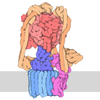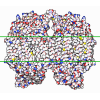[English] 日本語
 Yorodumi
Yorodumi- PDB-9b8o: Synaptic Vesicle V-ATPase with synaptophysin and SidK, State 3, Vo -
+ Open data
Open data
- Basic information
Basic information
| Entry | Database: PDB / ID: 9b8o | ||||||
|---|---|---|---|---|---|---|---|
| Title | Synaptic Vesicle V-ATPase with synaptophysin and SidK, State 3, Vo | ||||||
 Components Components |
| ||||||
 Keywords Keywords | PROTON TRANSPORT / Membrane / Synaptic / Complex | ||||||
| Function / homology |  Function and homology information Function and homology informationregulation of opioid receptor signaling pathway / Metabolism of Angiotensinogen to Angiotensins / Transferrin endocytosis and recycling / Ion channel transport / Amino acids regulate mTORC1 / RHOA GTPase cycle / Insulin receptor recycling / eye pigmentation / central nervous system maturation / transporter activator activity ...regulation of opioid receptor signaling pathway / Metabolism of Angiotensinogen to Angiotensins / Transferrin endocytosis and recycling / Ion channel transport / Amino acids regulate mTORC1 / RHOA GTPase cycle / Insulin receptor recycling / eye pigmentation / central nervous system maturation / transporter activator activity / negative regulation of autophagic cell death / plasma membrane proton-transporting V-type ATPase complex / rostrocaudal neural tube patterning / cellular response to increased oxygen levels / positive regulation of transforming growth factor beta1 production / synaptic vesicle lumen acidification / intracellular organelle / proton-transporting V-type ATPase, V0 domain / extrinsic component of synaptic vesicle membrane / endosome to plasma membrane protein transport / lysosomal lumen acidification / clathrin-coated vesicle membrane / endosomal lumen acidification / vacuolar proton-transporting V-type ATPase, V0 domain / vacuolar proton-transporting V-type ATPase, V1 domain / vacuolar transport / proton-transporting V-type ATPase complex / neuron spine / head morphogenesis / osteoclast development / protein localization to cilium / regulation of short-term neuronal synaptic plasticity / neuron projection terminus / vacuolar proton-transporting V-type ATPase complex / dendritic spine membrane / regulation of cellular pH / syntaxin-1 binding / vacuolar acidification / ROS and RNS production in phagocytes / Neutrophil degranulation / regulation of synaptic vesicle exocytosis / cholesterol binding / : / regulation of neuronal synaptic plasticity / presynaptic active zone / response to amyloid-beta / autophagosome membrane / regulation of MAPK cascade / ATPase activator activity / synaptic vesicle endocytosis / excitatory synapse / positive regulation of Wnt signaling pathway / cilium assembly / transmembrane transporter complex / regulation of macroautophagy / angiotensin maturation / axon terminus / RNA endonuclease activity / proton-transporting ATPase activity, rotational mechanism / proton transmembrane transport / endoplasmic reticulum-Golgi intermediate compartment membrane / SH2 domain binding / receptor-mediated endocytosis / SNARE binding / regulation of long-term neuronal synaptic plasticity / neuromuscular junction / Schaffer collateral - CA1 synapse / terminal bouton / cilium / transmembrane transport / small GTPase binding / synaptic vesicle membrane / positive regulation of canonical Wnt signaling pathway / endocytosis / melanosome / synaptic vesicle / ATPase binding / presynapse / signaling receptor activity / presynaptic membrane / cell body / postsynaptic membrane / intracellular iron ion homeostasis / positive regulation of ERK1 and ERK2 cascade / endosome / receptor-mediated endocytosis of virus by host cell / endosome membrane / postsynaptic density / early endosome / lysosome / neuron projection / apical plasma membrane / protein domain specific binding / external side of plasma membrane / axon / lysosomal membrane / centrosome / ubiquitin protein ligase binding / synapse / endoplasmic reticulum membrane Similarity search - Function | ||||||
| Biological species |  | ||||||
| Method | ELECTRON MICROSCOPY / single particle reconstruction / cryo EM / Resolution: 3.2 Å | ||||||
 Authors Authors | Coupland, C.E. / Rubinstein, J.L. | ||||||
| Funding support |  Canada, 1items Canada, 1items
| ||||||
 Citation Citation |  Journal: Science / Year: 2024 Journal: Science / Year: 2024Title: High-resolution electron cryomicroscopy of V-ATPase in native synaptic vesicles. Authors: Claire E Coupland / Ryan Karimi / Stephanie A Bueler / Yingke Liang / Gautier M Courbon / Justin M Di Trani / Cassandra J Wong / Rayan Saghian / Ji-Young Youn / Lu-Yang Wang / John L Rubinstein /  Abstract: Intercellular communication in the nervous system occurs through the release of neurotransmitters into the synaptic cleft between neurons. In the presynaptic neuron, the proton pumping vesicular- or ...Intercellular communication in the nervous system occurs through the release of neurotransmitters into the synaptic cleft between neurons. In the presynaptic neuron, the proton pumping vesicular- or vacuolar-type ATPase (V-ATPase) powers neurotransmitter loading into synaptic vesicles (SVs), with the V complex dissociating from the membrane region of the enzyme before exocytosis. We isolated SVs from rat brain using SidK, a V-ATPase-binding bacterial effector protein. Single-particle electron cryomicroscopy allowed high-resolution structure determination of V-ATPase within the native SV membrane. In the structure, regularly spaced cholesterol molecules decorate the enzyme's rotor and the abundant SV protein synaptophysin binds the complex stoichiometrically. ATP hydrolysis during vesicle loading results in a loss of the V region of V-ATPase from the SV membrane, suggesting that loading is sufficient to induce dissociation of the enzyme. | ||||||
| History |
|
- Structure visualization
Structure visualization
| Structure viewer | Molecule:  Molmil Molmil Jmol/JSmol Jmol/JSmol |
|---|
- Downloads & links
Downloads & links
- Download
Download
| PDBx/mmCIF format |  9b8o.cif.gz 9b8o.cif.gz | 633.5 KB | Display |  PDBx/mmCIF format PDBx/mmCIF format |
|---|---|---|---|---|
| PDB format |  pdb9b8o.ent.gz pdb9b8o.ent.gz | 506.7 KB | Display |  PDB format PDB format |
| PDBx/mmJSON format |  9b8o.json.gz 9b8o.json.gz | Tree view |  PDBx/mmJSON format PDBx/mmJSON format | |
| Others |  Other downloads Other downloads |
-Validation report
| Summary document |  9b8o_validation.pdf.gz 9b8o_validation.pdf.gz | 3.9 MB | Display |  wwPDB validaton report wwPDB validaton report |
|---|---|---|---|---|
| Full document |  9b8o_full_validation.pdf.gz 9b8o_full_validation.pdf.gz | 3.9 MB | Display | |
| Data in XML |  9b8o_validation.xml.gz 9b8o_validation.xml.gz | 101.5 KB | Display | |
| Data in CIF |  9b8o_validation.cif.gz 9b8o_validation.cif.gz | 142.8 KB | Display | |
| Arichive directory |  https://data.pdbj.org/pub/pdb/validation_reports/b8/9b8o https://data.pdbj.org/pub/pdb/validation_reports/b8/9b8o ftp://data.pdbj.org/pub/pdb/validation_reports/b8/9b8o ftp://data.pdbj.org/pub/pdb/validation_reports/b8/9b8o | HTTPS FTP |
-Related structure data
| Related structure data |  44350MC 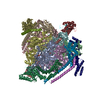 9b8pC  9b8qC  9brbC  9brcC  9brdC M: map data used to model this data C: citing same article ( |
|---|---|
| Similar structure data | Similarity search - Function & homology  F&H Search F&H Search |
- Links
Links
- Assembly
Assembly
| Deposited unit | 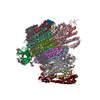
|
|---|---|
| 1 |
|
- Components
Components
-Protein , 5 types, 5 molecules HUbfp
| #1: Protein | Mass: 28359.020 Da / Num. of mol.: 1 / Source method: isolated from a natural source / Source: (natural)  |
|---|---|
| #3: Protein | Mass: 33331.523 Da / Num. of mol.: 1 / Source method: isolated from a natural source / Source: (natural)  |
| #5: Protein | Mass: 21618.553 Da / Num. of mol.: 1 / Source method: isolated from a natural source / Source: (natural)  |
| #8: Protein | Mass: 9502.132 Da / Num. of mol.: 1 / Source method: isolated from a natural source / Source: (natural)  |
| #10: Protein | Mass: 39118.578 Da / Num. of mol.: 1 / Source method: isolated from a natural source / Source: (natural)  |
-V-type proton ATPase ... , 6 types, 14 molecules PadeghijklmnoL
| #2: Protein | Mass: 51160.359 Da / Num. of mol.: 1 / Source method: isolated from a natural source / Source: (natural)  | ||
|---|---|---|---|
| #4: Protein | Mass: 94950.836 Da / Num. of mol.: 1 / Source method: isolated from a natural source / Source: (natural)  | ||
| #6: Protein | Mass: 40341.934 Da / Num. of mol.: 1 / Source method: isolated from a natural source / Source: (natural)  | ||
| #7: Protein | Mass: 9203.020 Da / Num. of mol.: 1 / Source method: isolated from a natural source / Source: (natural)  | ||
| #9: Protein | Mass: 15815.833 Da / Num. of mol.: 9 / Source method: isolated from a natural source / Source: (natural)  #11: Protein | | Mass: 13389.262 Da / Num. of mol.: 1 / Source method: isolated from a natural source / Source: (natural)  |
-Sugars , 3 types, 10 molecules 
| #12: Polysaccharide | 2-acetamido-2-deoxy-beta-D-glucopyranose-(1-4)-2-acetamido-2-deoxy-beta-D-glucopyranose Source method: isolated from a genetically manipulated source #13: Polysaccharide | alpha-D-glucopyranose-(1-2)-alpha-D-glucopyranose-(1-3)-alpha-D-glucopyranose-(1-3)-alpha-D- ...alpha-D-glucopyranose-(1-2)-alpha-D-glucopyranose-(1-3)-alpha-D-glucopyranose-(1-3)-alpha-D-mannopyranose-(1-2)-alpha-D-mannopyranose-(1-2)-alpha-D-mannopyranose-(1-3)-[alpha-D-mannopyranose-(1-6)-alpha-D-mannopyranose-(1-6)]beta-D-mannopyranose-(1-4)-2-acetamido-2-deoxy-beta-D-glucopyranose-(1-4)-2-acetamido-2-deoxy-beta-D-glucopyranose | Source method: isolated from a genetically manipulated source #16: Sugar | ChemComp-NAG / | |
|---|
-Non-polymers , 5 types, 46 molecules 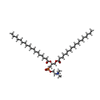
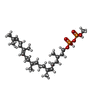
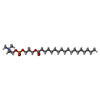
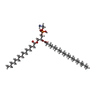





| #14: Chemical | ChemComp-PC1 / #15: Chemical | ChemComp-WJP / | #17: Chemical | ChemComp-LP3 / ( | #18: Chemical | ChemComp-PTY / #19: Chemical | ChemComp-CLR / |
|---|
-Details
| Has ligand of interest | N |
|---|
-Experimental details
-Experiment
| Experiment | Method: ELECTRON MICROSCOPY |
|---|---|
| EM experiment | Aggregation state: PARTICLE / 3D reconstruction method: single particle reconstruction |
- Sample preparation
Sample preparation
| Component | Name: Synaptic vesicle V-ATPase with synaptophysin and SidK, state 3, Vo Type: COMPLEX / Entity ID: #1, #11, #3, #5-#6, #9-#10 / Source: NATURAL |
|---|---|
| Source (natural) | Organism:  |
| Buffer solution | pH: 7.4 |
| Specimen | Embedding applied: NO / Shadowing applied: NO / Staining applied: NO / Vitrification applied: YES |
| Specimen support | Grid material: GRAPHENE OXIDE / Grid type: Homemade |
| Vitrification | Instrument: FEI VITROBOT MARK IV / Cryogen name: ETHANE / Humidity: 100 % / Chamber temperature: 277 K |
- Electron microscopy imaging
Electron microscopy imaging
| Experimental equipment |  Model: Titan Krios / Image courtesy: FEI Company |
|---|---|
| Microscopy | Model: TFS KRIOS |
| Electron gun | Electron source:  FIELD EMISSION GUN / Accelerating voltage: 300 kV / Illumination mode: FLOOD BEAM FIELD EMISSION GUN / Accelerating voltage: 300 kV / Illumination mode: FLOOD BEAM |
| Electron lens | Mode: BRIGHT FIELD / Nominal defocus max: 1900 nm / Nominal defocus min: 1000 nm / Alignment procedure: COMA FREE |
| Specimen holder | Cryogen: NITROGEN / Specimen holder model: FEI TITAN KRIOS AUTOGRID HOLDER |
| Image recording | Electron dose: 37.5 e/Å2 / Film or detector model: TFS FALCON 4i (4k x 4k) |
- Processing
Processing
| EM software | Name: PHENIX / Version: 1.21_5207 / Category: model refinement |
|---|---|
| CTF correction | Type: PHASE FLIPPING AND AMPLITUDE CORRECTION |
| 3D reconstruction | Resolution: 3.2 Å / Resolution method: FSC 0.143 CUT-OFF / Num. of particles: 198533 / Symmetry type: POINT |
 Movie
Movie Controller
Controller







 PDBj
PDBj